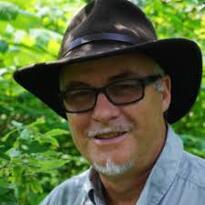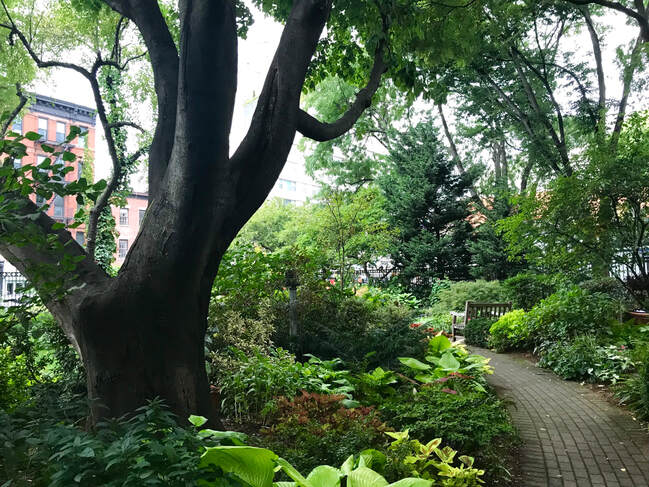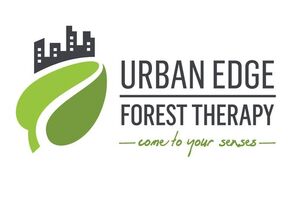 In my previous blog I described Naomi Sach’s and Gwenn Fried’s presentations and Regina Ginyard's and Jenn Hertzell's audience participation activity at The Transformative Properties of Horticulture symposium held on November 15. Concluding the activity was a presentation by Amos Clifford, founder of the Association of Nature and Forest Therapy Guides and Services, the organization from which I received my training as a forest therapy guide. It seems only appropriate to be writing about Amos’s presentation during Thanksgiving week, as there is so much about his insights to be thankful for, and in what is a virtuous circle, I am confident that he in turn would express his gratitude for more-than-human world around us. Amos began by asking if Forest Therapy can play a role in responding to the global climate crisis, or as he noted, what should more aptly be called simply “the crisis” given its broad scope: the omnipresence of plastics, the “insect apocalypse” and collapse of entire ecosystems. He noted that we are in a “liminal time” –- an in-between time when things are not predictable. This was his motivation in founding ANFT. In the course of a vision fast, he asked, “what can I do as I enter my elder year to help?” “We have to remember who we are in the context of this beautiful planet and all the beautiful creatures on this planet. We need to remember that we’re in relationship with more than human beings. This is not about being a naturalist or scientist. It is about being in our bodies. It is about being in our senses. It is about being here, not getting to there. … Plants are fundamental in what we do. Our relationship with plants, thinking of them as sentient beings, capable of having a relationship with us, thinking of the forest as sentient and intelligent. Science is beginning to catch up to this understanding.” Amos highlighted the importance of imagination, noting that Albert Einstein said that “imagination is more important than knowledge.” He encouraged the audience to think of imagination as a sensory field, one that inspires. "Through an imaginal journey we can explore trees, stones, clouds, and bird by shifting how we experience them. We can shift to a remembering, recognizing that it was not very long ago in human history that we thought of the more-than-human world as sentient." "People are born out of the Earth. We are a part of Earth. Earth has seeded within us the potential to transition into a deeper state of knowing. And now is when we need action. When do you write the best poetry in your life? The best songs? When you are suffering. May this be the time that the poetry of who we are can be beautiful." "We need to transition our way of thinking, to move away from desiring “more of” to rather something “different from”. We need a connection to nature that embraces whimsy, curiosity, and following nature’s simple pleasures. These are new ways of knowing and being, and they help we redefine “wellness” to take into account “what it means to be whole. We can't be whole apart from a relationship with nature, because we are nature." Amos asked audience members to take a look at their hands, and to appreciate all that they have done. He added, "The mind is wise enough to hold its place in the family of things. He conveyed the notion of "plants as persons" and noted how "plant blindness" has become a disease. "We overlook plants, misunderstand their time scale. For example, forests are migrating. Yet, they move in "forest time", over periods of time that are difficult for human beings to readily discern." Amos went on to postulate the notion of new ways of being and knowing in relationship with nature. He described the idea of "Earth Dreaming", which came to him in connection with the concept of an "entangled mind" and that "leads to the question of whether immersion in this field of vegetal learning cause an evolutionary leap, the Earth's invitation to learn a new way of being. Relationships are like neurons within an expanded mind. Think of the forest or plants and places as part of our brain. What is diversity and reciprocity? What if the entangled mind is what knows how to live?" How lucky we are to hear Amos's insights and perspective.
0 Comments
 Last week I was fortunate to attend and offer a small Forest Therapy walk following a symposium on The Transformative Properties of Horticulture, sponsored by the Madison Square Park Conservancy. The symposium featured inspiring speakers engaged in breathtakingly impactful work. Naomi Sachs, a professor of therapeutic landscape architecture at University of Maryland and founder of the Therapeutic Landscapes Network, a resource for gardens and landscapes that promote health and well-being, spoke about "restorative landscapes" and the importance of providing access to nature in healthcare settings. Hospitals are stressful places where patients and their visitors are at their most vulnerable. “Health”, she added, is not just “not being sick”. It is also about physical, emotional, and spiritual wellbeing, which is enhanced by natural environments. She described the notion of “restorative landscapes”, which are landscapes that promote health and wellbeing, and could be as simple as a fire escape or memorial--any place that where a person can find peace and solace. Sachs described the many scientific and medical studies supporting the beneficial impact of nature, including—among medical patients—more rapid recovery from surgery, reduced patient complaints, and reduced need for medication, and--among the general population--improved memory and attention and a reduction in ruminative thoughts. Gwenn Fried, Manager of Horticulture Therapy Services at NYU Langone Medical Center, then spoke about therapeutic horticulture in public spaces and underscored the value of targeting the certain populations that can most benefit from it, including:
Regina Ginyard and Jenn Hertzell then engaged the audience in a networking activity focused on green spaces that give people joy. Ginyard is a founding member of Black Urban Growers (BUGS), an organization committed to "building networks and community support for growers in both urban and rural settings." Jenn Hertzell is a Bronx-based farmer and founder of At the Rood: An Herbal Eastery, Farm, and Apothecary that exists to create opportunities for people of the African Diaspora to hear their relationships with their bodies and with the earth. How fortunate we are that scholars and practitioners like Sachs, Fried, Ginyard, and Hertzell are improving lives through the transformative properties of horticulture. Stay tuned for my next blog entry to learn about what Amos Clifford said at the conference. |
About this Blog
Hi! I'm Nancy Kopans, founder of Urban Edge Forest Therapy. Join me on an adventure to discover creative ways to connect with nature in your daily life, ways that are inspired by urban surroundings that can reveal unexpected beauty, with the potential to ignite a sense of wonder. Archives
April 2023
Categories
All
|

 RSS Feed
RSS Feed